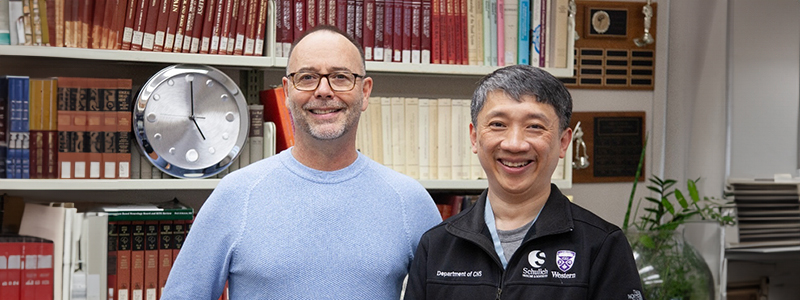In a Canadian first, surgical team at London Health Sciences Centre performs robotic assisted spinal surgery

By Celine Zadorsky, Special to Schulich Medicine & Dentistry Communications
Chronic back pain affects nearly eight million Canadians and is a condition that can become quite debilitating. For Dave Meyn, a clinical neuroscience patient at London Health Sciences Centre (LHSC), chronic back pain led to sciatica in his right leg, and extreme pain in his lower back.
“It was very debilitating, to the point that the shooting pain in my right leg caused me to stumble and fall,” said Meyn. “It was difficult to live with and started to negatively affect my day-to-day life.”
After many visits with his family doctor, chiropractors, and massage therapists, Meyn turned to LHSC and became the first patient in Canada to receive a robotic assisted surgery on his spine, called a direct lateral spine surgery, using the MazorX Spinal Robot. Schulich School of Medicine & Dentistry funded the original cost of the robot for research purposes, before transferring the equipment to LHSC for clinical use.
“Usually, we would do this surgery from the back, which means the patient would lie on their stomach,” said Dr. Victor Yang, neurosurgeon at LHSC and professor of Neurosurgery, Medical Imaging, Orthopedic Surgery, and Medical Biophysics in the Department of Clinical Neurological Sciences at Schulich Medicine & Dentistry.
Because Meyn needed surgery in two spots on his spine, the surgical team was able to use this new robotic technology to perform a minimally invasive surgery from the side, called a direct lateral spinal surgery.
“Performing a surgery from this position can be quite challenging, but with the robot, it allows us to virtually see where the bone is within the patient's body, and then the robot maintains the trajectory we need and guides us towards the right direction,” said Yang. “This meant we were able to perform two minimally invasive surgeries at once without having to also reposition the patient.”
Eliminating a second surgery also led to decreased surgical time and a faster recovery, meaning Meyn was able to go home in just a number of days.
“When I woke up from the surgery, the sciatica pain in my leg was immediately gone. It was amazing,” recalled Meyn. “The surgery definitely did its job.”
The Clinical Neurosciences team, which includes members from vascular surgery and neuroanesthesia, at LHSC has successfully performed six minimally invasive surgical spinal procedures using this state-of-the-art technology.
“I think the use of robotic assistance will become more common for this type of procedure as it provides more consistency and, in general, better outcomes and care,” said Yang.
For Meyn, it was an honour to be the first in Canada to receive this surgery, but what is even more exciting is what this means for his future.
“I am excited to get back to my everyday life and some of the things I enjoy and also have a summer that is not full of pain, but rather freedom to do the things I want.”








